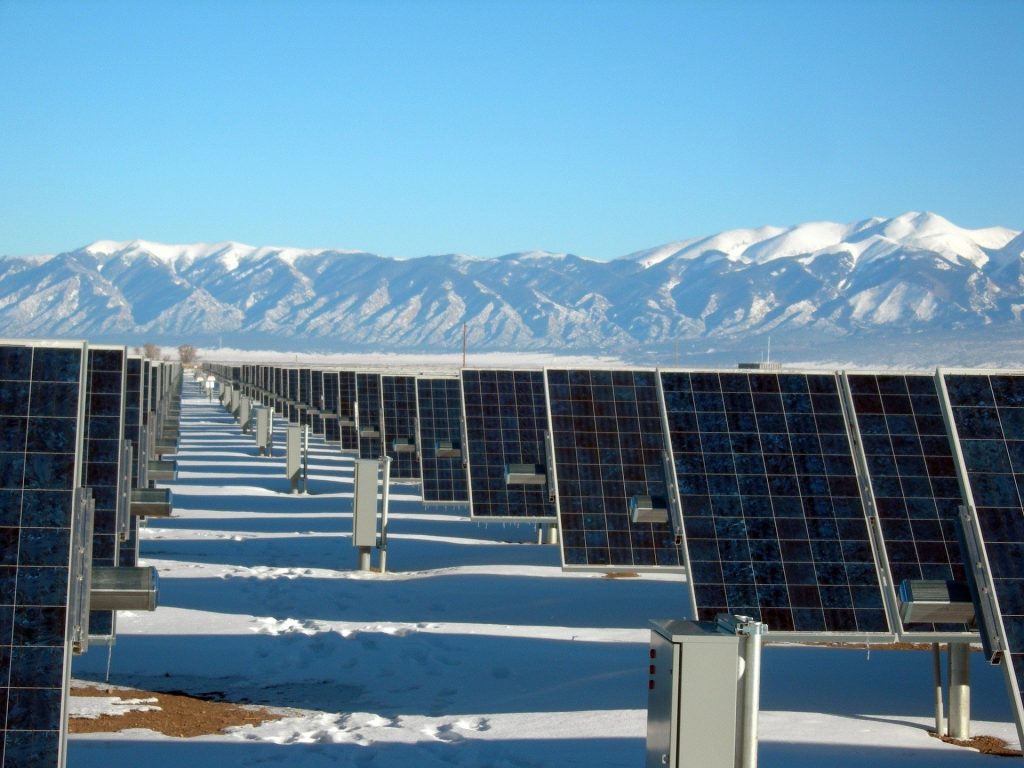Are you considering a ground mounted solar panel installation? What are the costs, as well as the pros and cons? Here we answer the most common questions.
Are ground mounted solar panels superior in terms of efficiency and wattage? And how do they compare to standard roof mounted solar panels?
This guide will help you navigate whether ground-mounted solar panels are the right choice for you and what you can do to get the most out of them.
Let’s begin…
Pro tip: Avoid upsells and confusing packages—choose a provider with a clear, fixed-price quote that won’t change. Heatable, a Which?-approved solar installer, offers transparent pricing with no surprises.
What are Ground Mounted Solar Panels?
As their name suggests, ground-mounted solar panels are on the ground as opposed to the roof of a property.
This means that they require adequate space to be housed, but it also means they are an ideal solution to maximise energy generation, since the installation is not limited by the size and shape of a roof.
However, due to the fact that ground-mounted solar panels require an adequate amount of land, they are typically only used for commercial applications, such as large scale solar farms.

Why Choose Ground Mounted Solar Panels?
If you want to generate as much energy as possible and have adequate land to house them, then ground mounted panels are the go-to choice.
If you have more open, unused space on your property than roof space these could be a good option and provide many benefits.
However, there are a few things to consider when thinking about them including whether you will need planning permission.
Additionally, it’s important to consider whether installing ground mounted panels could cause damage to the local environment, and how they will look on your property.
For these reasons, it is more common that ground-mounted solar panel systems are used for commercial solar projects or large-scale solar farms.
Ground Mounted Solar Panels & Solar Trackers
For commercial ground-mounted solar arrays, solar trackers can be a valuable investment.
They can increase energy output by as much as 25% for single axis trackers and an additional 10% for dual axis trackers.
However, solar trackers are not typically used in residential solar installations due to their weight and unsuitability for domestic roofs.
Additionally, they are costly, have moving parts, and require frequent maintenance, making them more practical for large commercial solar farms where the additional expenses can be justified.
How are Ground Mounted Solar Panels Installed?
Ground-mounted solar panels can be installed in a few ways, but are typically connected to a structure to help maximise sunlight exposure.
These structures commonly include the following types:
- A metal A-frame. This is fitted to a concrete base or a pole driven into the ground.
- A ballasted plastic box.
- A larger frame that can double up as another structure, such as a shaded garden area, a car stand or outdoor storage.
In addition to the panels themselves, a complete system will also need wiring, cabling, and inverters set up, as well as spacing between the panels to allow for adequate shading.
Ground Mounted vs Roof Mounted Solar Panels
There are various pros and cons to ground mounted and roof mounted solar panels.
Here is a summary of how they compare:
Benefits of Ground Mounted Solar Panels
- A bigger system – being able to install more, larger and heavier panels that may be restricted on a roof space means you will produce more energy.
- Future expansion – installing what you can afford today and expanding at a later date is much easier with ground-mounted panels.
- Ability to angle them at the optimal direction and tilt to harvest the maximum amount of sunlight.
- Airflow – there is more airflow around ground-mounted panels which will improve the efficiency of the panels.
- Easier to maintain – leaning and repairing are much easier when they are at a reachable height. This is a particularly important point if you live in a colder climate and need to clear snow from the panels often.
Cons of Ground Mounted Solar Systems
- Space – first of all your going to need the space for them, but even if this is at your disposable rooftops are dead space. Consider what else you might use the space for first.
- Cost more to install – you may need extra wiring and a trench dug to accommodate the wiring. More fixtures are also needed to install adding to the cost.
- Vulnerable to theft and/or vandalism.
- You may need planning permission.
Get a free estimate for your solar with the experts at Heatable:
- It’s free, easy, and without obligation
- Compare quotes & get the best prices
- Save up to £660 per year

Benefits of Domestic Ground-Mounted Solar Panels
The benefits of ground-mounted solar panels for domestic use are very much the same as rooftop panels.
You’ll reduce your energy bills, perhaps even earn money from putting energy back into the grid, all reducing your carbon footprint.
The choice between the two will largely come down to the space you have and your own preference for a ground vs roof solar system.
If you have the outdoor space and the choice is between a rooftop or a ground-mounted system, you’ll likely be able to generate more energy for your home with ground-mounted panels.
This is because of the restrictions on your roof, from the angle it faces (if it is not completely south-facing), and whether or not your roof is big enough to support a system big enough for the amount of energy your home needs to run off.
Related solar guides:
- How many solar panels do you need?
- Smart Export Guarantee
- Can you install solar panels in a conservation area?
- Best 4kw solar system with battery storage
- Sunshine hours map UK
- Best Solar Panels
- Solar panel output calculator
Do you need planning permission for ground mounted solar panels in the UK?
Planning permission will be needed for domestic and commercial ground-mounted solar panels if they meet any of the following:
- The panels are taller than 4m high
- The solar panels are less than 5 meters from the boundary of the property
- The solar panels take up more than 9 meters squared
- The solar panels are facing, visible from, or located on a highway, conservation area, or world heritage site
- Or if it is not the first solar setup on the property
You will need to apply for planning permission with your local council if any of the above apply to the ground-mounted solar panels you want to install.
There are serval ways you can help the decision for planning permission go in your favour.
This includes showing plans to make sure they have a minimal environmental impact (more on how to go about this later), increasing biodiversity around the solar panels, or making sure the land they are being placed on is dual purpose.
For example, land that is also used for grazing animals.
It will also help your planning permission application if you plan on placing your solar panels on brownfield land over greenfield which is more protected for environmental reasons.
Are Ground Mounted Solar Panels More Expensive?
The cost of ground-mounted and rooftop solar panels is very much the same, however, as mentioned above the installation of ground-mounted can be slightly more.
This comes from extra wiring being needed, often more frames and trenches that may need to be dug.
If you opt for a tracking system (see below) you will have a slightly higher upfront cost.
Though this is quickly earned back as ground-mounted tracking systems are much more efficient.
Types of Ground Mounted Solar Panel Systems
- Standard ground mounts – these have their frames driven into the ground at a fixed angle, some can be manually adjusted to account for seasonal changes.
- Pole-mounted solar panels – this means your solar panels can be more elevated than the standard frame and can have tracking systems incorporated as the panels have the space to tilt.
Tracking Ground Mounted Systems
An extra benefit from ground-mounted solar panels means you can take advantage of the ability to use tracking ground-mounted solar panels, which is usually not possible on a rooftops due to the extra weight and angle of the roof.
Tracking solar panels mean they can move with the sunlight throughout the day, capturing the full amount of sunlight and therefore becoming much more efficient in the energy they can produce.
Tracking solar panels come with either a single axis to track the sun through the day or a dual axis that can move in line with the seasons as well.
Of course, these come with a larger price tag, but you can expect them to be 20% more efficient than the usual static solar panels.
Ecological Impact of Ground Mounted Solar Panels
When thinking about installing ground-mounted solar panels it is important to also think about the ecological impact they may have.
If done properly there can be benefits of both green energy being generated and the local environment.
According to the Building Research Establishment, infrastructure in solar farms impacts less than 5% of its ground space.
Solar panels can create a refuge for small animals, insects, and birds, as well as letting the soil return to its natural state if the area was once used as agricultural land.
Essentially, they can create microhabitats that will increase bio-diversity.
But there can be harm done to the local environment too, particularly with large-scale solar farms if care is not taken.
But there can be harm done to the local environment too, particularly with large-scale solar farms if care is not taken.
For example, Karen Tanner, a researcher at the University of California, Santa Cruz who studies the biodiversity around several solar farms states that though some of the reasons for the loss in bio-diversity around solar farms are unclear, e.g. there is some evidence to suggest there is a loss of some plant life and soil erosion from rainwater run-off.
Therefore, extra care must be taken to ensure these issues are monitored on an ongoing basis and that the local community and land owners are made aware of the risks and how to mitigate them.
How to increase biodiversity around your ground-mounted solar panels
The main reason plant life can be lost around ground-mounted solar panels is from the shadows they cast onto the ground.
By spacing the panels enough apart, angling them, and increasing the height of the panels it is possible to increase the light underneath them to get even a small amount of sunlight under them for parts of the day.
Placing the panels like this will also help achieve better rainwater runoff to avoid soil erosion.
Then look to plant plants that will thrive in the local area.
Native plants will help the local population of insects, pollinators, small mammals, and reptiles to thrive.
If measures like these are taken, especially on land that was once used for agriculture with monoculture, fertilizers, and pesticides used, having ground-mounted panels installed will have a positive impact.
Ground Mounted Solar Panels Conclusion
If you are thinking about starting a ground mounted solar project, it makes sense to get professional advice and support.
Get in touch to find out how we can help through the entire process, from initial planning to installation.
We can provide a no-obligation and free quote for your commercial and/or domestic ground mounted solar installation.
